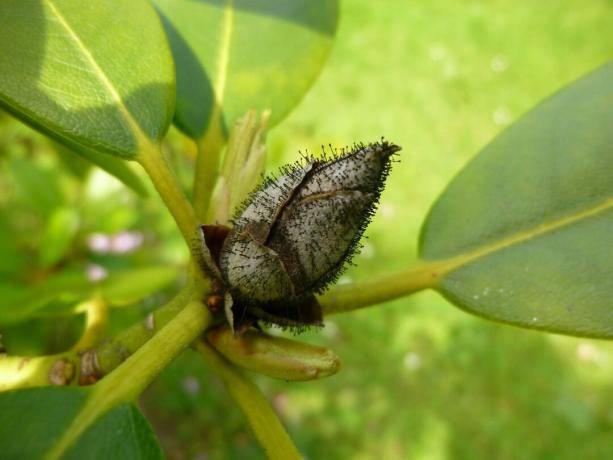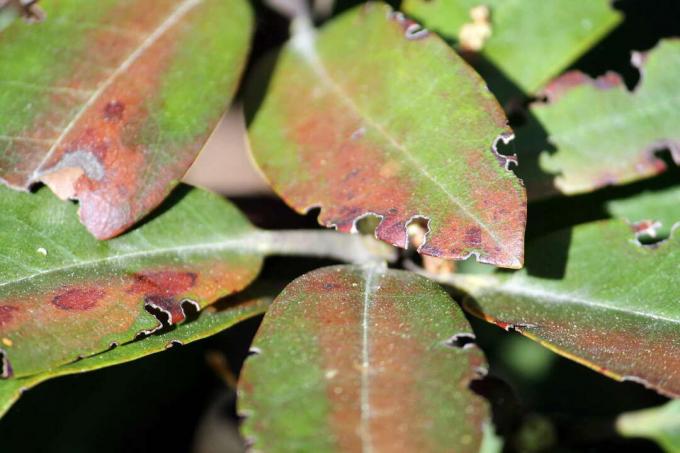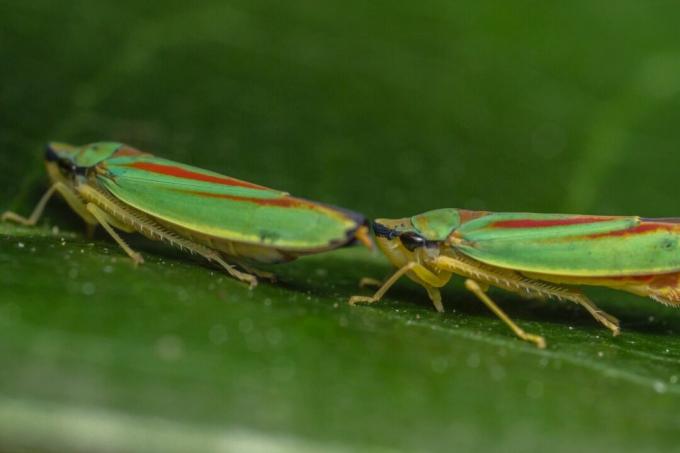Rhododendrons are usually beautiful to look at. However, you can find out here what to do with yellow leaves, black buds and scuff marks.

As easy to care for they are in every other respect - the genus of Rhododendrons (rhododendron) is susceptible to fungal diseases and animal pathogens are also wreaking havoc in the evergreen foliage of the rhododendron. We list the most important pests and diseases below and give tips on how best to deal with them.
contents
- Rhododendron: yellow and brown leaves
-
Common fungal diseases in rhododendrons
- mildew
- Leaf spot disease
- rust
-
Animal pests on rhododendrons
- Black vine weevil (Otiorhynchus sulcatus)
- Rhododendron bug (Stephanitis rhododendri)
- Rhododendron cicada (Graphocephala fennahi)
- Whitefly
-
Yellow leaves from improper care
- Calcium chlorosis
- Nitrogen deficiency
Rhododendron: yellow and brown leaves
The discoloration of the leaves usually has two causes: either the plant is malnourished or suffers from a lack of water or it has been attacked by a fungal disease. Depending on the cause, the yellow or brown lesions can be different. In order to do something about the discoloration, the source of the damage must first be identified. Here you will find a list of common fungal diseases of the rhododendron.

Common fungal diseases in rhododendrons
- characteristics: Floury gray coating on leaves and partly stems
- reason: Occurs when there is insufficient ventilation and excessive humidity
- Countermeasure: Cut back the infected areas generously
- Home remedies: Spray milk diluted with water (in a ratio of 8: 1) on the remaining shoots and leaves; rinse after 20 minutes and repeat two or three more times; the lecithin in milk kills fungal spores
Leaf spot disease
- characteristics: Combines several clinical pictures; generally there is leaf loss, stunted growth and spots on the leaves
- reason: Leaf spots can be caused by various fungi (over 20 species known), damp weather conditions promote infestation
- Preventive measures: Choose favorable locations; Avoidance of too shady locations; preventive use of fungicides
rust
- characteristics: Can be identified by yellow-orange spore beds on the underside of the leaf, is often confused with leaf spot diseases
- reason: Fungal pathogen; occurs very rarely
- Preventive measures: Optimal choice of location and soil conditions; needs-based fertilization; Keeping the leaves dry (when watering, for example) The use of pesticides is possible, but not necessary
Animal pests on rhododendrons
But not only fungal diseases can affect your rhododendron. Animal pests can also cause disease in your rhododendron.

- characteristics: Adult animals feed on leaves; Larvae partially damage roots; the feeding marks are visually unattractive, but no danger to the plant
- reason: Infestation by adults and larvae; widespread in German gardens
- Combat: Pesticides are mostly ineffective because animals keep themselves covered; Collecting; reliable control by parasitic nematodes like ours Plantura HB nematodes between April and May; Lightly work the neem press cake into the soil to drive away larvae
Rhododendron bug (Stephanitis rhododendri)
- characteristics: Light yellow speckles of the leaves, which become brown-black, necrotic spots in the course; the pests are easily recognizable from the underside of the leaves
- reason: Infestation by the bedbugs is favored if the location is too sunny and the weather is warm
- Preventive measure: Pour occasionally with Bennesseljauche; use soft irrigation water; loose and mulched soil
- The use of a pesticide is usually not necessary
- characteristics: Sucks in buds; Suction damage only minor; the real damage is caused by a fungus (Pycnostysanus azaleae); the females scratch buds to lay their eggs, the fungal spores penetrate through the wound, the buds turn black and die
- reason: Infestation by adult animals and subsequent fungal disease; one of the most common pests on the rhododendron
- Combat: Break out the infected buds and dispose of them (not on compost, but in household waste); Yellow panels hang up to detect infestation, use insecticides against adult cicada

- characteristics: Feeding on leaves; speckled symptoms on top of leaf; Plant loses vitality; Leaves die off; leaves sugary honeydew on leaves, which is a breeding ground for fungi; then mostly black discoloration of the leaves
- reason: Infestation by adults and larvae
- Countermeasure: Display of yellow boards; Fight larvae with systemic pesticides, parasitic wasps
Yellow leaves from improper care
If there is neither pest infestation nor disease, the rhododendron was cared for incorrectly. If the leaves of the evergreen shrub become increasingly chlorotic, this is usually due to a pH value that is too high or too low. Because if the pH value of the soil is not in the optimal range, the nutrients contained in the soil cannot be properly absorbed.
Calcium chlorosis
- characteristics: At first the young leaves change color from yellow to brown, the leaf veins remain green; if no countermeasures are taken, stunted growth occurs
- reason: The soil pH is too high (above 5), so the iron in the soil cannot be absorbed, there is an iron deficiency, later there is a manganese and magnesium deficiency
- Countermeasures: Transplant in lime-free soil; Watering with soft rainwater; Fertilize with mulch, compost or an iron-heavy fertilizer
Nitrogen deficiency
- characteristics: The sheet turns yellow; the plant only sprouts sparsely and only forms small leaves that fall off quickly
- reason: The supply of nitrogen is insufficient, too little or wrong fertilization
- Countermeasures: Fertilize with mineral nitrogen fertilizer, this is available to the plant particularly quickly
Incorrect care not only affects the leaf color, but also the formation of flowers. So that your rhododendron can decorate your garden vital, green and full of flowers, we have everything you need here Care of rhododendrons collected for you.
